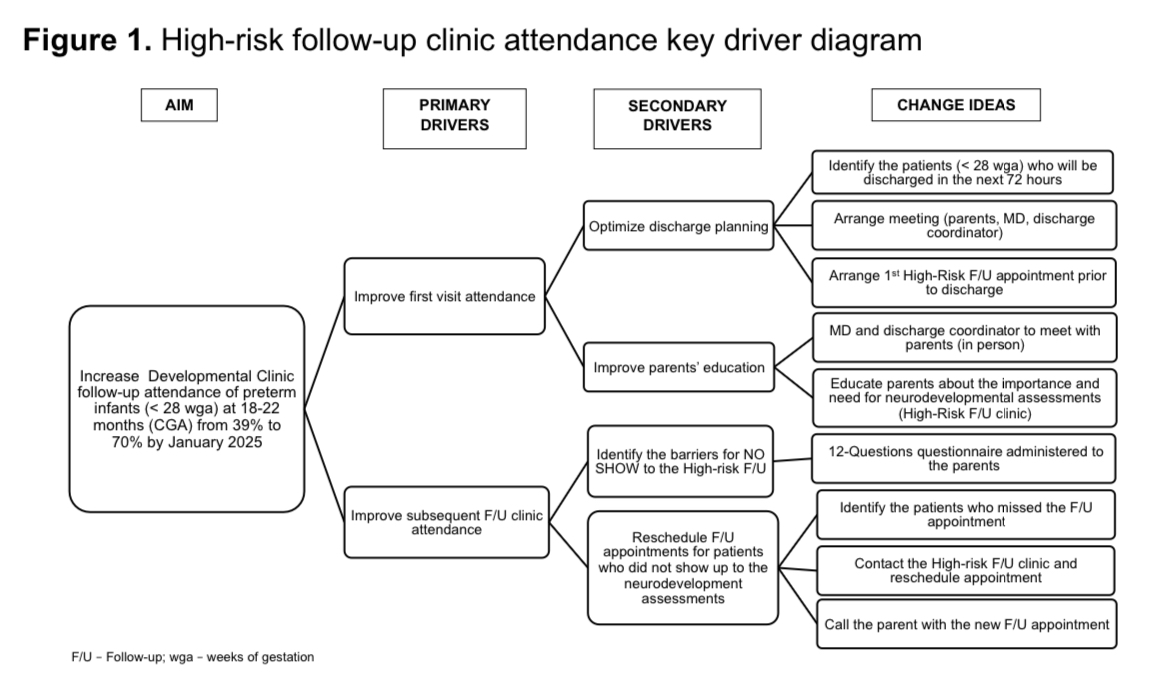Neonatal Quality Improvement 2
Session: Neonatal Quality Improvement 2
077 - Quality Improvement Initiative to Increase Patient Attendance in the High-Risk Neonatal Follow-up Clinic
Friday, April 25, 2025
5:30pm - 7:45pm HST
Publication Number: 77.6449
Bianca M. Vamesu, University of South Alabama College of Medicine, Mobile, AL, United States; Noor Ibrahim, University of South Alabama Children's and Women's Hospital, Mobile, AL, United States; Kelechi Ikeri, University of South Alabama College of Medicine, Mobile, AL, United States; Karen Jackson, University of South Alabama Children's and Women's Hospital, Mobile, AL, United States; Manimaran Ramani, University of Alabama School of Medicine, Mobile, AL, United States; Michael Zayek, University of South Alabama, Mobile, AL, United States
- BV
Bianca M. Vamesu, MD
Assistant Professor of Pediatrics
University of South Alabama Children's and Women's Hospital
Mobile, Alabama, United States
Presenting Author(s)
Background: Tracking disability rates in extremely preterm infants is essential for early intervention, tailored support, parental preparedness, and informed health policy. Loss to follow-up undermines these benefits, reduces data quality, and may increase long-term costs. At our institution, attendance for the 2-year Bayley Scale evaluation, a national standard for identifying adverse outcomes, is only 39%.
Objective: To increase Developmental Clinic Follow-up attendance of extremely preterm infants (gestational age < 28 weeks) at 2 years corrected age, from 39 % to 70% by January 2025.
Design/Methods: This project was conducted from January 2020 to October 2024 using the Plan-Do-Study-Act (PDSA) tool. We retrospectively compared the developmental clinic follow-up attendance of extreme premature infants before and after practice changes. The practice changes (process measures) were implemented in February 2022 (parents’ education, schedule 1st appointment prior to discharge home) and April 2024 (identify the patients who missed the follow-up appointments and reschedule the appointments). A ten-question survey was used to identify barriers to attending developmental follow-up visits.
Results: A predischarge meeting with parents did not impact 1-year or 2-year attendance rates, which were 83% and 39 % at baseline, compared to 79 % and 40 % during the QI period, respectively. The only significant improvement was seen at the 7–9-month visit, where attendance increased from 35 % to 52 %, p< 0.05. Of the 49 parents surveyed, only 27 (55%) responded. The main barrier identified was lack of awareness of upcoming appointments (Table). Follow-up calls after missed appointments are still in early implementation, with total scheduled rates for the 2-year appointment reaching a peak of 75 % (Figure 2).
Conclusion(s): Educating parents prior to home discharge is essential for encouraging attendance at developmental visits, particularly during the first year. Although we have not yet met the 70% attendance target, sending reminders and making calls closer to later appointments may improve attendance at the 2-year visit.
Key Driver Diagram

Developmental follow-up clinic non-attendance barriers
.jpg)
Two-year neurodevelopmental follow-up
.jpg)


